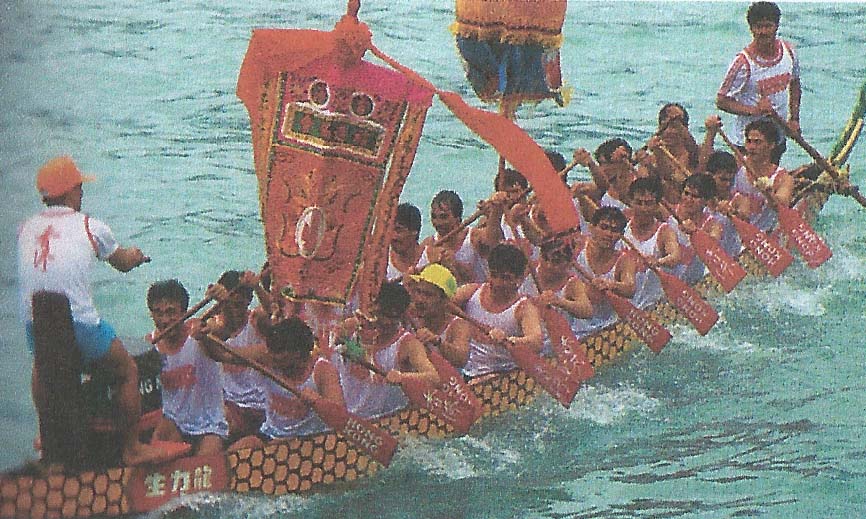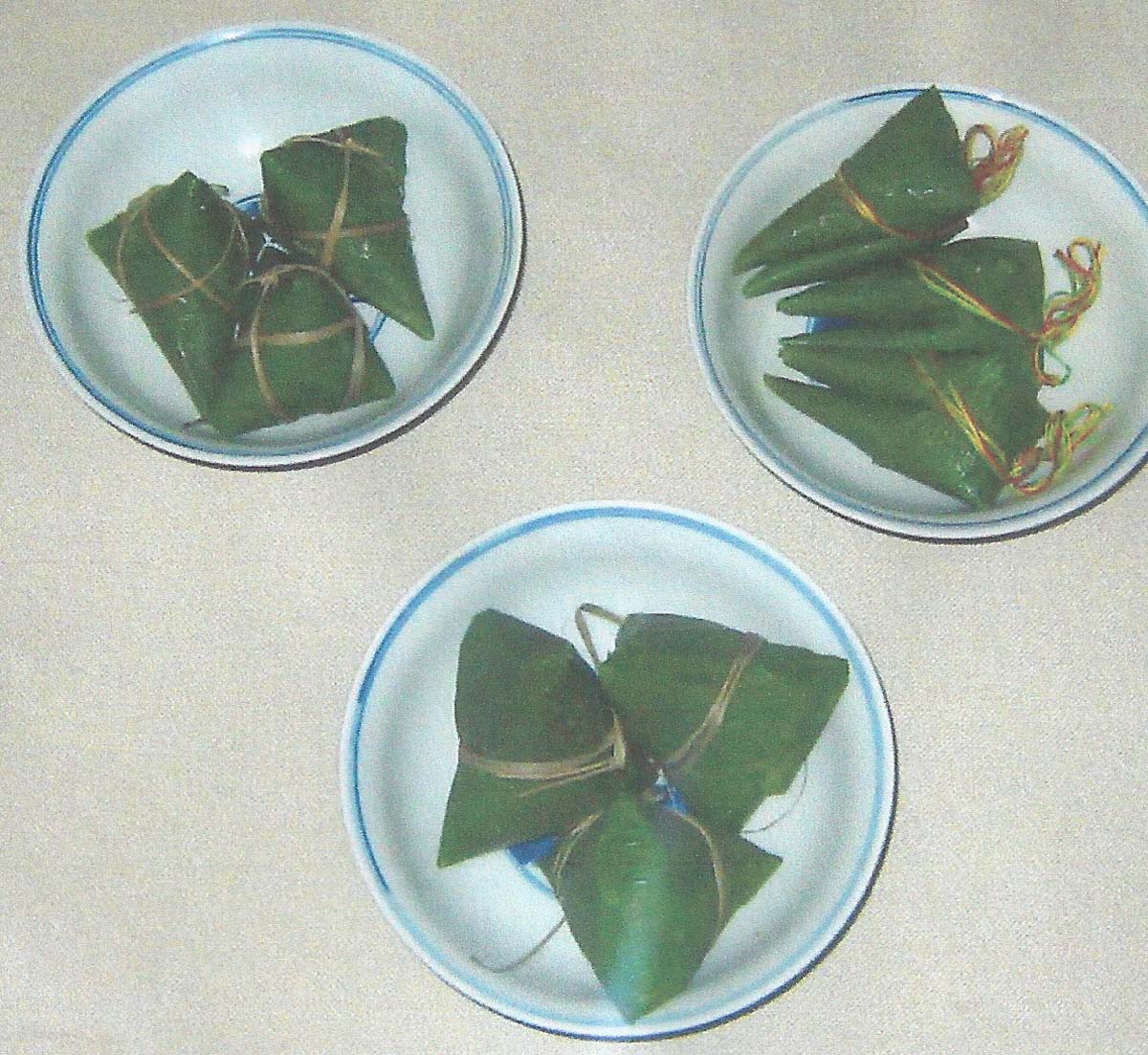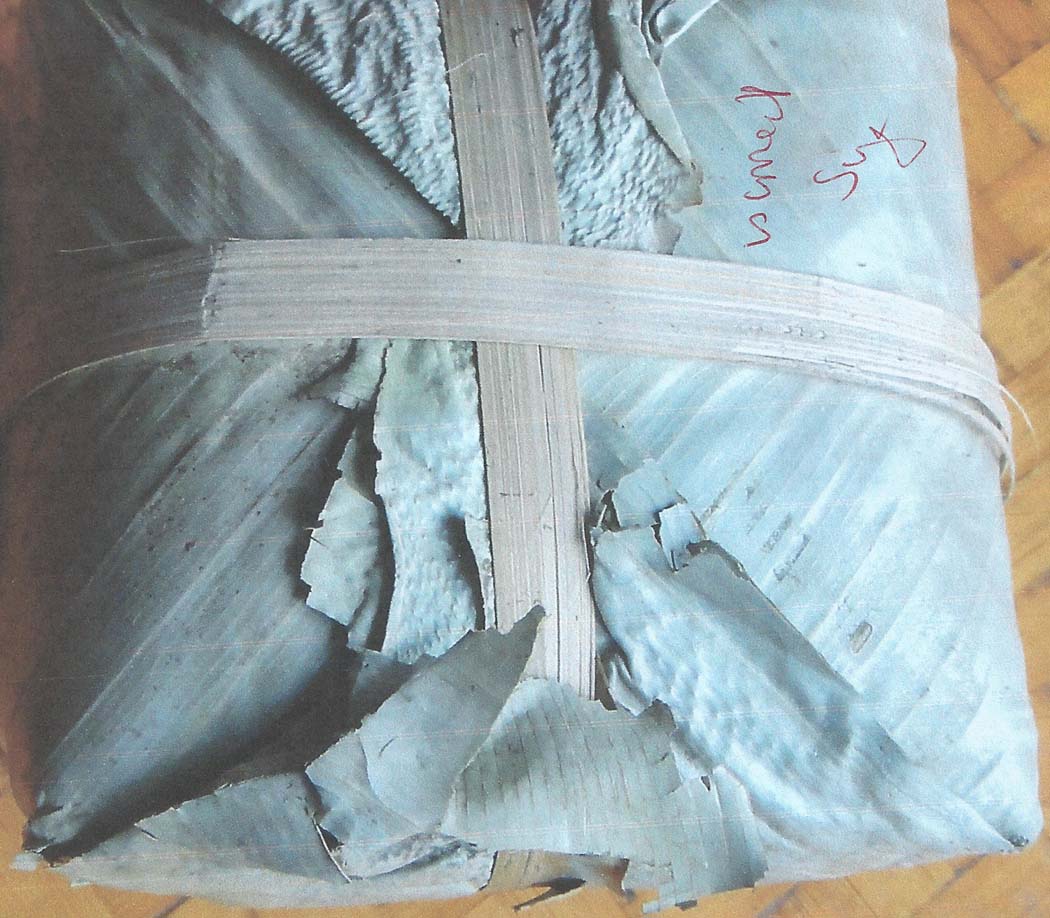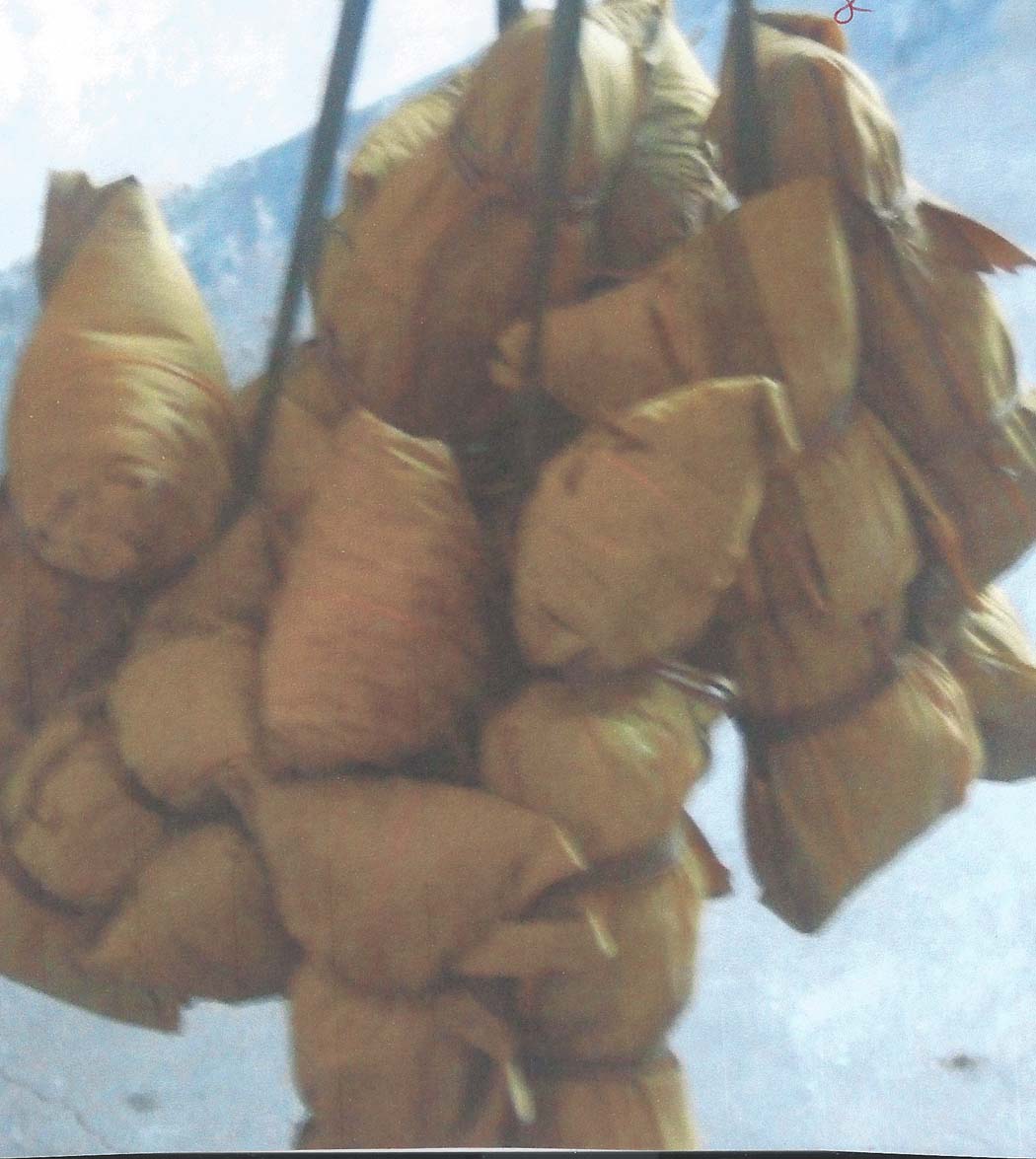
| What is Flavor and Fortune? |
| How do I subscribe? |
| How do I get past issues? |
| How do I advertise? |
| How do I contact the editor? |
Read 13122010 times
Connect me to:
| Home |
| Articles |
| Book reviews |
| Letters to the Editor |
| Newmans News and Notes |
| Recipes |
| Restaurant reviews |
| Article Index (all years, slow) |
| List of Article Years |
| Article Index (2026) |
| Article Index (last 2 years) |
| Things others say |
| Related Links |
| Log In... |
| Authors |
| Categories & Topics |
Rice Dumplings, Dragon-boat Races, and Qu Yuan
| by Zheng Nan |
Holidays and Celebrations
Winter Volume: 2013 Issue: 20(4) page(s): 10 - 13
 The Chinese call rice dumplings zongzi. Some historians say they are the first special food created by the ancestors of this Chinese nation, and that they demonstrate lots of the national spirit in their dietary culture and their historical records going back more than two thousand years. Furthermore, they have strong feelings about them and about the Dragon-boat Festival when they use them.
The Chinese call rice dumplings zongzi. Some historians say they are the first special food created by the ancestors of this Chinese nation, and that they demonstrate lots of the national spirit in their dietary culture and their historical records going back more than two thousand years. Furthermore, they have strong feelings about them and about the Dragon-boat Festival when they use them.
RICE DUMPLING EVOLUTION: People wash reeds or bamboo leaves, soak glutinous rice, and wrap this in triangle-shaped dumplings. They fill the leaves with rice and meat and/or red bean paste, sometimes jujube paste or similar items, then they steam or boil them.
Early on, these dumplings were known as horn millet or jiao su. Today these dumplings are generally known, as already indicated, as zongzi. Few researchers understand their real significance. It includes that the Chinese custom of eating rice dumplings is deeply rooted in the soil of ancient Chinese agriculture and that they are food products of a dietary life-style from years ago.
Pre-Qin documents record customs of people holding rituals they shared with the God of the Earth and Ceres, these took place after an autumn harvest. In the early years of the Zhou Dynasty (1045 - 256 BCE), the King who was then called the son of Heaven or Tian Zi, did attend these ceremonies with reverence and awe.
To repay the gods for their harvest, they consecrated the most precious sacrificial item to them. His was a cow with a seven-foot-long body, yellow hair, black lips, and two towering horns. This cow represented a sacrifice at the highest level and was called a tai lao ritual. The cow they killed had two beautiful bent horns and was called Chun Mu and Shuo Wen. Chun means cattle with yellow hair and black lips while er ya means a strong cow with a seven-foot-long body and thick horns. People attached great importance to the symbolic meaning of the cow's horns. The sacrifice occurred when Chinese ancestors prayed to the gods for blessings and gave thanks to them. Historians believe this ritual began no later than 2070 BCE; that was when the Xia Dynasty began.
In those times, people regarded food as their primary need, and that the gods should be in charge of their foods. They were in awe of them and wished for protection and help from the gods of the Earth and Ceres. Historians believe this was when primitive agriculture began.
A question asked is if that was when Chinese ancestors began farming? Historical records and archaeological excavations trace that to around twelve thousand years ago. In order to get the blessing of these agricultural gods, Chinese ancestors wanted to give them their most beautiful and most precious gifts, and they did with deferential hearts.
These gifts included the most beautiful and healthy girls in their communities. Even their own close relatives were given as sacrifices. In addition, they offered livestock such as cows, sheep and pigs. Although there are no precise descriptions of when and how they started to offer these sacrifices, there is reason to believe they did begin very early on.
The King, who was the son of Heaven, and feudal lords held great sacrifices frequently during the Xia, Shang and Zhou Dynasty times (21st - 16th century BCE; 1600 - 1045 BCE; and 1045 - 221 BCE, respectively). The number of animals offered is believed an alarming number.
Historians believe that the entire society’s material wealth was limited in ancient times, and that productivity then was low. Communities needed to maintain and people needed to survive, so they could not give away almost all they had during sacrificial times so they found alternative ways. They used typical symbolic sacrificial items such as big cattle and cattle horns. Thus, horn millet or jiao su came into being. These were close to the horn in shape and scale, and they gradually evolved into the current shapes. It was easy to remove their leaves and this enabled eating them.
Thus, the emergence of these horn-shaped millet dumplings gradually reduced the need to sacrifice their cattle. They needed to protect them and not sacrifice these important working helpers who plowed their fields. The entire society saw the value of their cattle, and so these changes gradually strengthened their society during Western Zhou Dynasty times as they did see their cows as important items for their food production.
Millet, originally born in the Yellow River basin, is one of ‘five grains’ in pre-Qin historical records. It was an important food in that river basin, and was traced back to the pre-Qin period. Their wrapped parcels of millet in leaves of Zizania latifolia, were thoroughly cooked and eaten on May 5th and the summer solstice. They took on the name of zonzi or horn millet, and became the sacrificial food used instead of cattle during these early times. They had significance for them and they had the blessedness of the first specially-shaped foods made; and the Chinese made them with great artistry.
DRAGON BOAT FESTIVAL AND QU YUAN WORSHIP: Known as Duan Wu, Duan Yang, and/or Chong Wu, there are various thoughts about the origin of the May 5th Dragon Boat Festival. Some believe the day selected for dragon worship was done in the past for their ancestors. Others say it was for a king named Gou-jian and the rebuilding of his country. Others think it to memorialize the scholar Jie-zitui; or to memorialize the patriotic poet Qu Yuan who lived in the Chu kingdom, or perhaps to memorialize hero Wu-Zixu, or to memorialize Cao-E, or even a day to worship ancestors and gods in Chinese Daoism.
Dragon ancestor worship is the most frequently given notion for this holiday, and literature of prehistoric times indicates that Dragon culture was a Chinese national faith and the formation of symbiotic culture earlier than any written records.
At its earliest, dragon-boat racing during this festival probably came from Rang Zai who made efforts to avert calamities by offering sacrifices. This old custom was aimed to avoid them and dispel evil spirits. Prehistoric people did notice that plague and disease did occur frequently in the lunar month closest to May 5th. That could have been why they created activities to placate their problems in this season.
Early folk believed that ghosts, gods, and monsters had superpowers. Rang Zai was the only measure they could take to show their respect and keep them at arm's length from various evils and demons. They wanted Rang Zai to send disasters away and assure them they would not come back. A ceremony held in the Chu area near Hunan and Hubei had these features.
The custom of Rang Zai when boating season is coming to an end is to prepare an offering with wine and yellow paper made to resemble money. Rang Zai offers something to the dead by rowing downstream, burning yellow paper money, pouring a libation as an offering, and putting a curse on any plagues and disasters hoping they would go down stream. This was known as ‘Sending the mark’ and was when they held up their flags and played their drums.
It was also when they quietly returned their boats to the high bank, took them under a pavilion and waited for next year. Then when these activities took place and should disease occur, everyone made paper boats, the colors the same as their dragon boats, and then burned them waterside.
Sending the mark was one purpose for racing boats during Dragon Boat Festival. The whole process was solemn, respectful, and mysterious, paper boats and candles lit the sky as they sent the mark. This activity had a long history and was popular. It is interesting to note that sacrifices of the Dragon Boat Festival in the South Korean Jiang Ling area retain similar activities.
These two most ancient customs, Rang Zai and Send the Mark, worship the dragon and their ancestors. They are about a boat race popular on the Yangtze River in the southern part of China. Horn millet eaten during these times promoted cultural convergence between the Yellow River and the Yangtze River as horn millet food is common around these rivers.
Over time, ancient meanings were gradually replaced by more realistic, clear, and touching images; and it was then that Qu Yuan became the symbol of the Dragon Boat Festival. He is permanently memorialized with reverence, and has been so generation after generation. Qu Yuan (340-278 BCE) was from the Chu Kingdom then called the Zigui of Hubei province. He is the earliest romantic poet in China. His original name is Ping Mi, his courtesy name is Yuan, and in childhood he studied hard and had lots of ambition. When he grew up he developed the trust of Chu-huaiWang, the Chu King, and was appointed as Zuotu and San Lv Dafu, both official positions in the Chu Kingdom. This was during the Warring States Period when he often discussed state affairs with the king, participated in the formulation of laws, advocated ‘clean government,’ managed state affairs according to law, and employed worthy people to reform the political system. He joined the Qi kingdom to resist the Qin Kingdom.
With Qu Yuan's efforts, the Chu kingdom gained enhanced strength; and he was unwilling to compromise and follow the bad examples of others. A group of jealous folk persuaded the King of Chu to ignore Qu Yuan's opinions, and that estranged the King from him. In 305 BCE he was ejected from the captial of the Chu Kingdom.
After the younger King of Chu, Xiang, took over the throne, Qu Yuan was still persecuted, and later exiled south of the river area. In 278 BC, Bai Qi, then general of the Qin kingdom, captured the capital of the Chu kingdom, and on Qu Yuan's idea still wanted to devote himself to his country. However, as he was unable to do so. He jumped into the Miluo River and committed suicide for his beliefs of his motherland.
In ghost literature in the Northern and Southern Dynasties, Qu Yuan and the Dragon Boat Festival came together. It is said that: ‘In Jian Wu times of the Han dynasty, Qu Qu saw a scholar claiming to be Qu Yuan and told Qu Qu that "I heard you will sacrifice me but your offerings are stolen by a dragon. This year you can plug the leaves of the offering and tie them with colored silk. You know the dragon fears these two things." Qu Qu complied. Interestingly, there is no such story about Qu Yuan and the Dragon Boat Festival until the Liang Dynasty. Chinese people always kill or are killed, conquer or are conquered. There was continuous war for more than three centuries from the Eastern Han to the Northern and Southern Dynasties, and this made the Chinese people refuse anything ugly in life. They yearned for goodness in society.
Qu Yuan, with his proud personality, grand ideals, talent, brilliant achievements, and rough experiences, naturally became the image scholars admired and someone respected by common people. When he threw himself in the Miluo River, the people of Chu grieved over his death and wrapped rice in bamboo leaves. They threw them into water as offerings to him. They continue to do so every year on May 5th. This made a legacy about his kind and upright qualities and lofty patriotism.
The combination of Qu Yuan and the Dragon Boat Festival are great issues, and because of Qu Yuan, this festival is meaningful. It touched people and lasted for a long time. It is now deeply rooted in the hearts of the Chinese and they all know this story. Qu Yuan's achievements made him great; he is the father of Chinese national literature.
Dragon Boat Festival activities have increased including boat racing, eating rice dumplings and eggs, drinking wine, especially realgar wine, hanging sagebrush and incense bags, hanging garlic, etc. Although there are cultural differences with respect to where it is held, its history, and so forth, everyone eats wrapped rice dumplings, everyone enjoys the boat races, and everyone takes part in the drinking of this wine.
Literature, in 12th century says the rice dumplings are signs of prosperity, particularly in Hangzhou. The custom in the Zhejiang Province is that every family buys peaches, willow branches, sunflowers, pomegranates, rush leaves, rice dumplings, and colorful water balls. They offer sacrifices on their doorsteps from May 1st until dragon-boat-day, and Taoists hang wormwood and grass on their doors, or paintings with tiger heads and the mythology of Bai Ze; these are all symbols of blessing.
Some families write couplets with the words ‘May 5th Tian Zhong festival, they paint a red mouth and white tongue. Big or small, every family in Hangzhou burns incense for a month.
There can be competing sunflowers and pomegranates, fragrant gardenias and sagebrush, golden rice dumplings, calamus-like jade, and beautiful scenery, but everyone, rich or poor, enjoys this festival, and eats nutritious foods such as rice dumplings and eggs during the Dragon Boat Festival; it improves people's lives. The drinking of realgar is to both drive away evil spirits and kill insects, the wine makes for a cheerful atmosphere, and beliefs associated with it may improve health.
To make this realgar wine, people cut the root of the rushes, dry them and mix them with this wine or with liquor. These beverages and the accompanying rice dumplings improve the Dragon Boat Festival with lots of vitality.



RICE DUMPLINGS HAVE SIGNIFICANCE and the Chinese believe that Qu Yuan and the agricultural gods and customs avert calamity. They have believed this since China’s 5th and 6th centuries while rice dumplings offer historical continuity and do avert calamity. Offering these sacrifices is both entertainment and sport, and the horn shape millet foods are delicious.
By the 18th century, rice dumpling culture was almost universal in China, even in remote and minority areas. We now know there are cattle leg dumplings, shuttle dumplings, pig dumplings, triangle dumplings, and New Year dumplings. Everyone eats and enjoys dumplings at this time of year; many enjoy them all year.
The Guangxi Chuang Nationality use glutinous rice dumplings, others use humming bird dumplings, spear dumplings, and Maonan triangle dumplings. The Jing nationality eat chopping block dumplings, the Mulao Nationality enjoy dog tongue dumplings, Shui people make and adore pepper, pork, and pea dumplings, the She nationality makes and eats pillow dumplings, the Dai make and ingest many dumpling packages, and so on. Thus, Dragon Boat Festival and its foods have believers and do-ers in virtually all populations.
In China and outside of it, both Chinese and Vietnamese like rice dumplings. They wrap them in circles or squares, the latter often made with banana leaves. These symbolize heaven and earth. Eating them means combining Heaven and Earth, also asking for good weather, good harvest, and good luck. Cambodians fill their hip-pockets with layers of glutinous rice, red beans, and red jujubes; they call them ‘bag dumplings’ and steam them before stripping off the hip-pocket and cutting and eating its contents.
In Thailand, rice dumplings are packaged in long strands with green bamboo leaves. Dumplings in Myanmar mix banana and shredded coconut stuffed in glutinous rice, while in the Philippines, they make long-shaped rice dumplings as Christmas food. In Malaysia, rice dumplings vary; they use fresh meat, red bean paste or shredded coconut stuffing among other things. In Indonesia, rice dumplings are made of glutinous rice with fresh meat, mushrooms, and onions. The custom of the Dragon Boat Festival in Korea means eating round cakes they call wheel cakes made of cooked and mashed new Artemisia leaves and rice flour; these are similar to Chinese green cakes.
Dragon Boat Festival customs impact Japan where swordlike leaves of calamus and Eupatorium fortunei water are made. Although there is no Dragon boat, a 'carp flag' flies, here rice dumplings have been introduced from China, as have many of the already mentioned items. Most are quite popular. In Ancient times some dumplings were known as ‘thatch’ because they were packaged in the above mentioned materials.
Some people soak glutinous rice in lixivium; another ancient Chinese tradition. Japanese rice dumplings have various shapes and can be sweet or not. Imperial rice dumplings there became famous in the Emperor’s Palace during Edo Times (1603 ~ 1867 CE). They are very different from dumplings in China.
There are broadly distributed corn dumplings in America, Mexicans package their dumplings in coarse exteriors and fill them with meat, and peppers or corn, and they wrap them in banana leaves. Corn dumplings in Costa Rica are flat, square, and wrapped in fresh banana leaves with interiors filled with sticky corn, chicken, beef, carrots, potato, olives, and coconut milk or beef broth. Latin American Indians fill theirs in banana leaves, too, but with beans.
In modern times, changes in production and ways of living mean there are rice dumplings made and filled in different ways, with many different influences from the past. These are particularly popular in peasant communities.
The artistic shapes of early rice dumplings had considerable cultural heritage in China. They always carried dreams of the future and are still favorites in people’s lives especially during Dragon Boat Festival season. Every Chinese feels close to the four thousand years of dumpling culture. They know they are to give thanks to Qu Yuan's spirit and they know they help advance one torch of their national culture.
_____
Zheng Nan has a doctorate from the Heilongjiang University in Harbin and now teaches at the Institute of Chinese Dietary Culture in Zhejiang Gongshang University in Hangzhou, China. She specializes in Chinese food culture and history, specifically that of Chinese and foreign cultures. She also cooperates with Professor Zhao Rongguang at this university doing important research on these topics.

Copyright © 1994-2026 by ISACC, all rights reserved
Address
3 Jefferson Ferry Drive
S. Setauket NY 11720